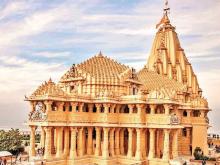
Somnath Temple
The Somnath Temple is the sacred site of the First Aadi Jyotirling, Lord Shree Somnath Mahadev, and is also considered the sacred ground where Lord Shri Krishna embarked on his final journey to his Neejdham.
Situated on the western edge of the Indian subcontinent, along the Arabian Ocean shore in the state of Gujarat, the Somnath Temple holds a special place in pilgrimage history. Its significance is deeply rooted in ancient scriptures such as the Skandpuran, Shreemad Bhagavat, and Shivpuran.
The Rig-Veda, in a hymn quoted below, mentions Bhagvan Someshwar, elevating it to the stature of other great pilgrimages like Gangaji, Yamunaji, and the eastward Saraswati. This attests to the profound antiquity and importance of this sacred pilgrimage destination.
The Somnath temple is steeped in intriguing legends that pique the curiosity of both devotees and inquisitive tourists.
Chandra Dev Prabhas Patan
One such mythological tale recounts the penance undertaken by Chandra, the Moon God, at this sacred site to break free from a curse inflicted upon him by his father-in-law, Daksha Prajapati.
According to the legend, Chandra Dev was married to all 27 daughters of Daksha Prajapati, with his affection predominantly directed towards Rohini, while the others were neglected. This partiality incited Daksha Prajapati's anger, leading him to curse the moon, foretelling the loss of its radiance.
In a state of distress, the Chandra or Moon God descended to Prabhas Patan to seek solace and pray to Lord Shiva, hoping for relief from the curse. Lord Shiva, moved by Chandra's unwavering devotion, ultimately granted his request and lifted the curse. In gratitude, the Moon God erected a Jyotirlingam at this very location, which later became renowned as the Somnath temple.
Lord Shri Krishna's Neejdham
After being hit by an arrow, Lord Shri Krishna arrived at the sacred confluence of the rivers Hiran, Kapila, and Saraswati, where they meet the ocean. It was here, on the tranquil banks of the Hiran River, that He enacted His divine Neejdham Prasthan Leela.
Hari Har Tirthdham in Somnath is the hallowed site associated with Lord Shri Krishna's Neejdham Prasthan Leela. The spot where Lord Shri Krishna was wounded by a poacher's arrow is known as Bhalka Tirth.
At this location, the Geetamandir has been constructed, featuring the verses of the Shrimad Bhagavat Geeta inscribed on eighteen marble pillars. Nearby, you can find the Shri Lakshminarayan Mandir. The Balramji Cave is the place from which Lord Shri Krishna's elder brother, Balaramji, embarked on his journey to his nijdham-patal.
Parshuram Tapobhumi
As per legends, Bhagvan Parshuramji engaged in penance and sought redemption for his actions against Kshatriyas. Pandavas visited this place, took a sacred bath in the Jalprabhas, and erected five Shiv temples. The Somnath Trust has made substantial efforts to develop the entire Shri Krishna Neejdham Prasthan Tirth comprehensively.
Somnath Temple Structure
The Somnath temple, constructed in the style of Kailas Mahameru Prasad, is attributed to the visionary Sardar Shri Vallabhbhai Patel, often referred to as the "Iron Man of India."
The temple comprises the Garbhgruh (sanctum sanctorum), Sabhamandap (assembly hall), and Nrityamandap (dance hall), featuring a towering Shikhar (spire) that soars to a height of 155 feet. At its pinnacle sits a Kalash weighing 10 tons, while the Dhwajdand (flagstaff) stands tall at 27 feet with a circumference of 1 foot.
Notably, the Abadhit Samudra Marg and the Tirth Stambh (Arrow) serve as markers, pointing to an unobstructed sea route leading to the South Pole, which is approximately 9,936 kilometers away. This remarkable detail underscores the ancient Indian knowledge of geography and the strategic placement of the Jyotirling temple.
According to certain ancient texts, the temple's history is quite fascinating. It is said that during the Satya Yuga, King Somraj constructed the temple entirely from gold.
In the Treta Yuga, Ravana built it using silver, while in the Dwapara Yuga, Lord Krishna fashioned it from wood. Subsequently, King Bhimadev is credited with constructing the temple from stone. These assertions are found in some of our nation's ancient scriptures.
Adjacent to the main temple complex, there is a temple that was renovated by Maharani Ahalyabai.
☀️Summer (March to June)
Somnath is primarily a coastal city, and as a result, its climate is predominantly semi-arid, which can become scorching during the summer months. The summer season typically commences in mid-March and extends through June.
In March, the temperature is fairly comfortable for visitors, but it gradually rises. By April, it becomes significantly hot and humid, reaching its peak in May and June. Therefore, touring this city during these months is not advisable. Nevertheless, Somnath boasts some exceptionally beautiful beaches that still manage to attract visitors even during the most challenging period of the year.
Temperature range: Minimum temperature- 28 ℃, maximum temperature 38 ℃ (approx.)
⛈️Monsoon (July to October)
The arrival of the monsoon provides a welcome respite from the intense heat, causing the temperature to gradually decrease as the monsoon season advances. The monsoon persists in showering the city until the end of September, and sometimes even extends into mid-October. During this period, the entire region experiences increased windiness. While the town receives moderate rainfall, the weather remains quite humid. Despite the humidity, you can still take pleasure in the beautiful beaches to cool off.
Temperature range: Minimum temperatures - 25 ℃, maximum temperatures - 34 ℃ (approx.)
❄️Winter (November to February)
Winter is the most delightful season for a visit to Somnath. During this period, a significant number of tourists flock to Somnath, not just from within Gujarat but also from other states. Winter sets in from November and lingers until February. At times, the temperature can drop to below 10 ℃, creating extremely chilly conditions. However, the days are pleasant, providing ample opportunities for exploring the region and its nearby tourist attractions.
Temperature range: Minimum temperature - 10 ℃, Maximum temperature - 22 ℃ (approx.)
How To Reach Somnath
✈️ By Air
To reach the city of Somnath by air, you won't find a direct flight option because there isn't an airport located in Somnath itself. The closest airport to Somnath is the Diu airport, situated approximately 82 kilometers away.
From Diu airport, you can conveniently reach Somnath by taking a local bus or hiring a taxi. Diu airport enjoys good connectivity with major cities across India and even some international destinations.
Therefore, for those contemplating how to reach Somnath by air, the best approach is to first arrive at Diu airport and then proceed to Somnath using road transportation.
🚝 By Train
There are train services connecting Somnath to all major cities, and Somnath itself boasts a well-equipped railway station. The nearest railway station to Somnath is Veraval Junction. Train travel is a comfortable and cost-effective option in comparison to flights. Many travelers opt for this mode of transportation to resolve the question of how to reach Somnath by train.
🚗 By Road
You can access Somnath by bus as well, as there are well-maintained routes that connect Somnath to various parts of the state. Overnight bus journeys are available from major cities, offering comfortable travel options.
Depending on the distance you need to cover, you can choose between traveling by taxi or driving yourself to reach Somnath by road. The road network in this area is well-developed, without any challenging routes, making car travel a convenient choice that depends on the preferences of the tourists.
All hours are approx.
Ahmedabad to Somnath
By Road - 8 hours
By Train - 9.5 hours
Delhi to Somnath
By Road - 24 hours
By Train - 30 hours
Hyderabad to Somnath
By Road - 41 hours
Mumbai to Somnath
By Air - 2 hours
By Road - 17 hours
By Train - 17 hours
Pune to Somnath
By Road - 19 hours
By Train - 21 hours

